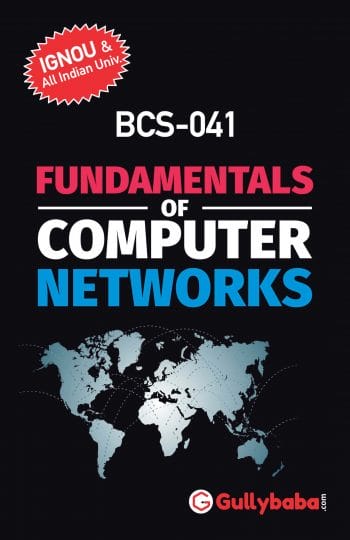#1 Best Selling IGNOU BCS-41 Help-Book & Study-Guide in IGNOU Marketplaces.
Get Good Marks in your BCA Computer Application Programme in the Term-End Exams even if you are busy in your job or profession.
We've sold over 58,647,936 Help Books and Delivered 73,608,336 Assignments Since 2002.
As our customers will tell you...yes, it really result-oriented.
IGNOU BCS-41 Code Details
-
University
IGNOU (Indira Gandhi National Open University)
-
Title
Fundamentals of Computer Networks
-
Language(s)
English
-
Code
BCS-41
-
Subject
Computer Application
-
Degree(s)
BCA
-
Course
Core Courses (CC)
IGNOU BCS-41 English Topics Covered
Block 1 - Concepts of Communication and Networking
- Unit 1 - Basics of Data Communication
- Unit 2 - Modulation and Encoding
- Unit 3 - Multiplexing and Switching
- Unit 4 - Communication Mediums
Block 2 - Networks and Devices
- Unit 1 - Network Classifications and Topologies
- Unit 2 - OSI and TCP/IP Models
- Unit 3 - Physical and Data Link Layer
- Unit 4 - Internet Working Devices
Block 3 - Network Transport and Application Layer
- Unit 1 - Network Layer
- Unit 2 - Transport Layer
- Unit 3 - Application Layer
- Unit 4 - Network Applications
Block 4 - Network Design & Security
- Unit 1 - Building A Simple Network
- Unit 2 - Introduction to Network Architectures
- Unit 3 - Introduction to Wireless and Mobile Networks
- Unit 4 - Network Security
IGNOU BCS-41 (July 2024 - January 2025) Assignment Questions
Q1. (a) Differentiate between parallel and serial communication. Give an example of each.
(b) Compare POP and IMAP.
Q2. (a) What is Ad hoc Wireless Communication System? Explain.
(b) What is better for computer communication — analog or digital? Justify your answer.
Q3. What is Windowing? How is flow control and reliability achieved through windowing at transport layer?
Q4. (a) Compare between CSMA/CD and Ethernet protocol. How does CSMA/CD resolve the problem of line connection? Explain.
(b) Differentiate between circuit switching and virtual circuit. Also explain the effect of router failure in virtual circuits.
Q5. Given data frame is 1101011011 and generator polynomial G(x) = x4+ x + 1. Derive the transmitted frame using CRC method. Write all the steps involved in the process
Q6. Differentiate between public key cryptography and private-key cryptography. Assume two prime numbers p and q are 13 and 17 respectively. Calculate private key and public key using RSA algorithm.
Q7. (a) Differentiate between pure ALOHA and slotted ALOHA. Give formulas for their throughput.
(b) Explain the importance of Sliding Window Protocol. Also, list the types of sliding window techniques.
Q8. (a) Write the step-by-step working of Link State Routing. Also, compare it with Distance Vector Routing.
(b) Explain leaky bucket algorithm for congestion control. Also list its advantages and disadvantages.
IGNOU BCS-41 (July 2023 - January 2024) Assignment Questions
Q1. (a) Differentiate between single mode and multi-mode optical fiber.
(b) Briefly discuss the functions of various layers involved in TCP/IP model, also mention the protocols defined under each layer.
Q2.(a) What is count-to-infinity problem in distance vector routing protocol? How does it happen? Explain with an example.
(b) Define angle modulation. What are its types? Discuss the limitations of angle modulation.
Q3. (a) Calculate the CRC for bit sequence 1101011011 and generator polynomial is 10011.
Note: Show all steps and calculation.
(b) What is Ad hoc Wireless Communication System? Explain.
Q4. (a) What is ICMP? Discuss the ICMP message categories. Also, give at least two examples of each ICMP message category.
(b) What is NIC? Write the techniques used by NIC for data transfer.
Q5. (a) Write the steps for Message Digest 5 (MD5) algorithm.
(b) Compare Hub and Switch. Give the advantages and disadvantages of both Hub and Switch. Briefly discuss the functions of layer-2 switch and layer-3 switch.
Q6. (a) Explain POP and IMAP. How does POP work? What are the advantages of IMAP over POP?
(b) Assume two prime numbers p and q are 3 and 5 respectively. Calculate private key and public key using RSA algorithm.
Q7. (a) Compare between CSMA/CD and token passing methods in Ethernet. Also explain how collisions are handled by CSMA/CD.
(b) What is round robin technique for transmission? How does polling differ from token passing?
Q8. (a) What is distance vector routing? Briefly discuss the problem of distance vector routing.
(b) What do you understand by the term Quality of Services (QoS). Discuss the techniques to improve QoS.
Buy BCS-41 Assignment
